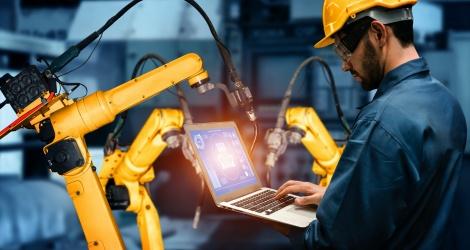Companies tackle their staff's employability
Employability refers to our ability to evolve within the labor market throughout our working lives. But in a changing world that requires everyone to be able to reinvent themselves, how can we ensure that employees maintain a high level of employability over time? And what resources do companies have to help them achieve this?

The end of preordained career paths, the acceleration of skills obsolescence, the emergence of new professions, an explosion in new technologies... The digital revolution has turned our working lives upside down in recent years, requiring real flexibility from those of us hoping to maintain optimum employability. To achieve this, we need to be able to reinvent ourselves throughout our careers and have the right tools and the right momentum to do so. How can companies facilitate this process? Numerous studies have been conducted in this vital area.
“The real challenge for young people in initial training is that in 85% of cases, the job they will be doing in 2030 doesn’t exist yet (2). So how do you prepare for jobs that don’t exist yet?”
The company in 2021 – a model facing fresh challenges
Irrespective of their size or location, today’s companies are a far call from the model that dominated the 20th century. Goodbye the preordained careers, standardization of tasks and uniform profiles by which jobs were previously defined. Hello customized careers and a spirit of initiative. This is a positive trend, as a company’s workforce is anything but homogeneous. On the contrary, it is enriched by differing and complementary profiles. As the Boston Consulting Group (1) explains: “Human capital (...) includes baby boomers, who were born during the dawn of the space age; Generation Xers, who rode the wave of personal computing; millennials, who grew up with mobile phones; and Generation Zers, who are digital natives. Each group has distinctive interests, values, knowledge, skills, experiences, and ambitions.” Far from being a disadvantage, this combination often proves to be a strength in terms of the skills required in a company. But it can also be a challenge when it comes to determining which aptitudes can or must be developed – aptitudes which can vary significantly between profiles.
The skills gap
Another phenomenon is also challenging the company and its employees – the skills mismatch. This refers to the widening gap between an academic world that equips future employees with skills, which could well already be obsolete by the time they arrive in a company, and companies forced to recruit profiles who they will then have to train on-the-job. “The real challenge for young people in initial training is that in 85% of cases, the job they will be doing in 2030 doesn’t exist yet (2). So how do you prepare for jobs that don’t exist yet?” asks Isabelle Rouhan, the founder of recruitment firm Colibri Talents and a specialist in future jobs, interviewed for the “Will humans find their place in the digital revolution of work?” episode of “The Hidden Power of Materials” podcast by Saint-Gobain. This is a burning question, as the gap created by this “skills mismatch” ultimately looks very much like an immense waste of money and resources. And it is particularly concerning given that it affects two in five employees – or around 1.3 billion people worldwide – according to the OECD (3).

Continuing training
But aside from the potential problems of skills misaligned with companies’ needs, the principle of continuing to train throughout our lives is not easy for all employees, although it has now been accepted that the ability to reinvent ourselves and to learn autonomously is central to increasing our employability. According to the definition provided by the McKinsey consulting agency in its article The most fundamental skill : Intentional learning and the career advantage (4) “Learning itself is a skill. Unlocking the mindsets and skills to develop it can boost personal and professional lives and deliver a competitive edge.”
What skills are needed now... and in the future?
With the development of robotics and artificial intelligence, everyone now knows that technical skills and mastery of tools need to be regularly reviewed and that some could even become redundant. “We are seeing accelerated obsolescence. In the 1970s, the OECD estimated that a technical skill had a lifespan of around 20 years. That's no longer the case. A technical skill has a maximum lifespan of five years,” says Isabelle Rouhan.
According to McKinsey, the adoption of AI and automation technologies will transform the workplace over the next 10 to 15 years, with people increasingly interacting with ever smarter machines. “These technologies and this human-machine interaction will bring numerous advantages (…), but they will also modify the skills required of human workers.”
Social skills are therefore likely to become increasingly valued. What is meant by social skills? Deloitte (5) believes that, beyond technical skills, skills such as creativity, leadership and critical thinking could become more important than ever. McKinsey is also advising companies (6) to help their employees create a toolkit that will be useful to them as their specific roles evolve. These tools particularly include “adaptability and resilience”, capacities now crucial in a world turned upside down by the health crisis, which has shaken up and accelerated the technical skills required (working from home, digitization of tasks, changing roles, etc.).
Establishing a learning culture
So, in order to increase our employability throughout our professional lives, our mindsets must first adapt to the existence of a continuing learning culture – including within the company. And employees themselves have a leading role to play in this change. Indeed, the Boston Consulting Group (1) believes that “In the past, responsibility for an individual’s professional development was assigned to employers and the state. Today’s world demands employees who are motivated to take responsibility for their personal growth.”
But then how can employees be supported in this learning culture? The company can, and must, approach every moment in an employee’s career as an opportunity for learning and make all training digitally-accessible in order to expand its reach. But it can also develop the content, as Isabelle Rouhan explains: “Involving everyone in this transformation [...] requires a training effort, but above all greater open-mindedness on the part of recruiters, HR directors and managers.”
White-collar and blue-collar workers – everyone is affected
This learning culture should not only be of interest to managers seeking to evolve. “Blue collar workers” are also involved in this movement, despite any lingering belief in fixed and immutable skills they might still have. Curiosity, the demand for new responsibilities, the desire for advancement and autonomy are all definitely advantages on which they can focus to receive continuing training throughout their careers. Because manual and technical roles are equally affected and technological training, security updates, digital skills and even learning languages to progress within the various international branches of a company, are all hot topics. “This is also why I want to roll out 4.0 in our plants,” explains Frédéric Pouille, Industrial Director of Saint-Gobain’s Insulation business. “This is to ensure that everyone working on the ground has the opportunity to gradually familiarize themselves with these digital tools. If every month or every other month you discover and practice a new functionality, you are developing your skills. And I think that managers need to be ready to create these conditions, even if there’s no visible short-term profit.” Because by always aiming higher, at each level and individually, the whole company will ultimately benefit from the journey.
Fortunately, a new vision is emerging in many companies, including Saint-Gobain, which supports its employees throughout their careers and even encourages them to become intrapreneurs, via the InPulse program. At Google, employees are invited to work 80% of their time on their professional duties and 20%... on whatever they want! Whether these are personal projects or ideas they would like to grow within the company, the important thing is for the subject to motivate them and for them to develop new skills in the process. Another inspiring example comes from Toyota, which bases its career policy on “kaizen” as a way of working. In practice, this means that everyone is encouraged to consider how they can improve the way they do things, both to help the company but also for their personal development. Training is therefore available at every stage of their development.
More autonomy and fewer preordained trajectories – promoting these changes in mindset and organization will enable companies and their employees to confidently address the changes that will continue to reshape our working lives.
(1) Fixing the Global Skills Mismatch / Boston Consulting Group
(2) Institute for the Future / Dell
(3) Enhancing employability / OCDE
(4) The most fundamental skill: Intentional learning and the career advantage / McKinsey
(5) L’organisation adaptable / Deloitte
(6) Building the vital skills for the future of work in operations / McKinsey
Credits : Blue Planet Studio/Shutterstock ; Drazen Zigic/Shutterstock
The latest stories
All stories
View more


